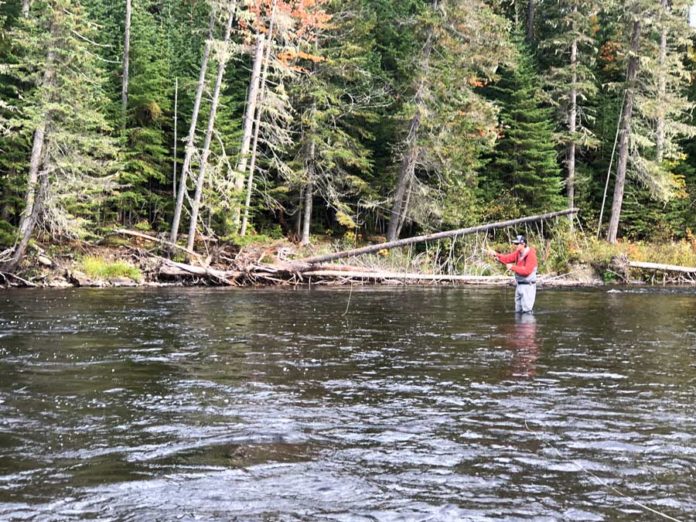Written by: Kaitlin Groundwater, Hook Set Fly Fishing
Photo by Mollie Simpkins
Over the course of my years providing fly-casting and on-the-water fly-fishing instruction for trout, I have noticed a common set of mistakes that seem to trip up anglers of all levels. These mistakes can be a source of great frustration and often have a negative impact on an angler’s fishing success and enjoyment of the sport. Here are some tips on how to avoid these errors and ensure a memorable day on the water.
1. Not Knowing How to Read the Water

Photo by Phil Monahan
You don’t need to have an in-depth understanding of the features of a given piece of water to find fish. (You can work up to that level of knowledge.) Just keep in mind two simple factors that drive trout behavior in any stream or river to determine their lies: 1. a consistent source of food that requires minimal energy expenditure and 2. protection from predators. Seams of converging currents, pools, and rocks provide opportunities for trout to sit in slower moving water, while also being located near faster currents where they can pick off food passing by. Additionally, rocks, undercut banks, and overhanging trees provide cover from birds and other predators lurking above the surface of the water.
2. Being Intimidated by Fly Selection

Photo by Phil Monahan
Opening a full fly box can be an intimidating experience, and I often see anglers paralyzed by too many options. The great news is you don’t have to be an entomologist to have a great day fishing! If you walk up to a new piece of water and do not know exactly what is hatching, simply stick to the classics. In this situation or if there isn’t an evident hatch, I always reach for my old standbys: Prince Nymph, Hare’s Ear Nymph, Pheasant Tail Nymphs, or a Woolly Bugger. All of these patterns represent a broad variety of aquatic species, at least one of which will most likely be in a piece of water at any given time. If there is an evident hatch, but you don’t know what it is, I find an Adams dry fly has a similar catch-all quality. Change colors and sizes until you figure out what they are feeding on, and use this success to inform choices on more specialized patterns.
3. Making Too Many False Casts

Photo by Sandy Hays
I get it: casting is fun. We all want to feel like Brad Pitt standing in the middle of a scenic Montana stream. However, too many false casts often lead to frustrating tangles and minimize the amount of time your fly is in or on the water, where fish can see it. To correct this, stick to a few simple techniques and rules. When you’re fishing where there is current, try to use the water tension at the end of your drift to launch your fly back to the top of the run. (This is also known as a “water haul” cast.) If you need to change direction or increase distance, try to limit yourself to three false casts. More time your fly is on the water often translates to more fish caught at the end of the day.
4. Improper Presentation and Hook Sets

Photo by Phil Monahan
Fly fishing is a numbers game. You want to give as many trout as possible the opportunity to see your fly, so you can catch more fish by the end of the day. I often see anglers pick up their fly before the end of their drift, if it is not immediately successful. For greater success, keep your fly in the water for as long as possible, and do not shortchange your drift. Additionally, setting the hook is free! Do it and do it often at any slight feeling of tension or hesitation in your fly or indicator. Trout takes, especially subsurface, can be quick and delicate, registering as only a split-second hesitation in your drift. The worst-case scenario when you set the hook, you have gotten your fly off a rock or stick, and the best-case scenario is that you have engaged with a sneaky trout.
5. Getting Discouraged

Photo by Phil Monahan
Mistakes are inherent to fly fishing and even the most experienced angler isn’t immune to catching a tree, missing a fish, or creating a bird’s nest tangle. However, I often notice that these mistakes and resulting frustration can turn the tide of the entire day. This frustration often leads to more mistakes and a snowball effect of irritation. The key to avoiding this is to brush off the small stuff, regroup, and get back to fishing. We ultimately fish because it is fun. I have consistently noticed that anglers who can laugh off mistakes and keep having fun are most often rewarded with a memorable and bountiful day on the water.
Kaitlin Groundwater operates Hook Set Fly Fishing in northern Virginia. Check her out on Instagram or shoot her an email.
Credit: Source link































